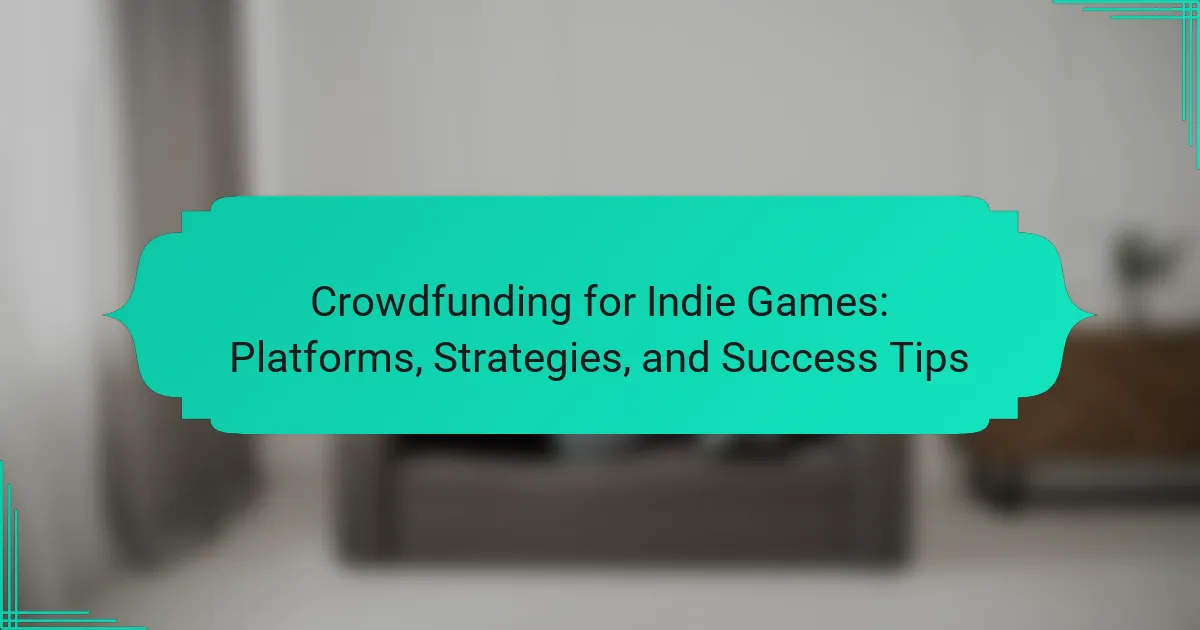Crowdfunding can be a game-changer for indie developers, offering a path to financial support and community engagement. This article explores key platforms like Kickstarter and Indiegogo, effective marketing strategies, community involvement techniques, and metrics for measuring success. Learn how to create compelling campaigns that resonate with backers and foster lasting relationships. Discover tips for overcoming common challenges in the crowdfunding landscape.
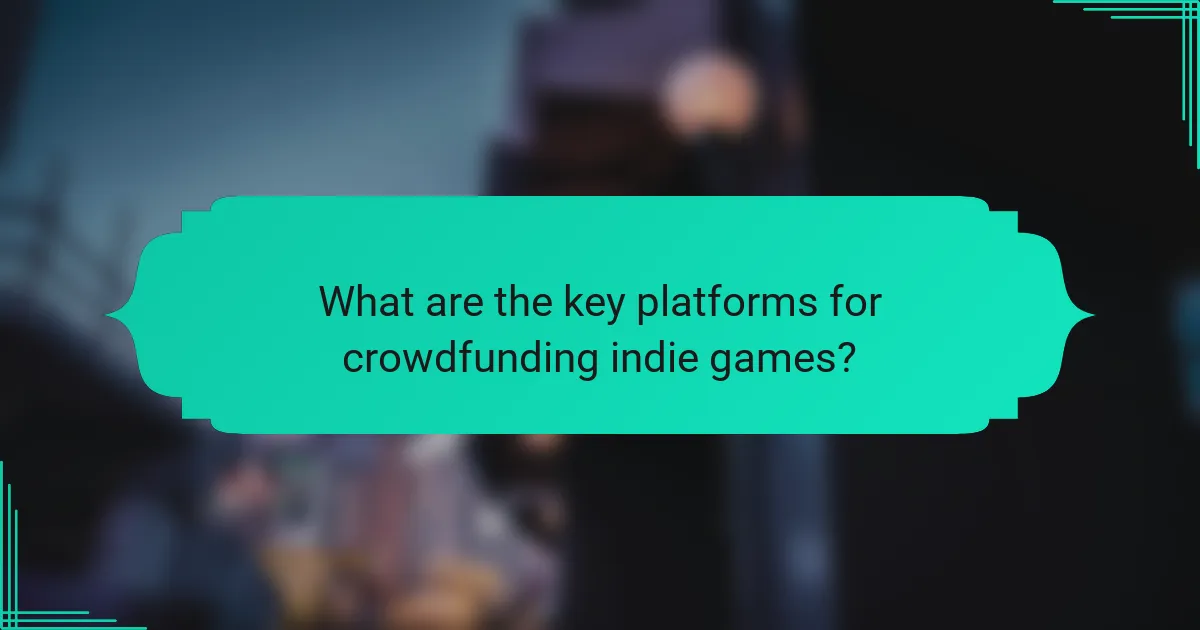
What are the key platforms for crowdfunding indie games?
Kickstarter, Indiegogo, Fig, Gamefound, and Patreon are key platforms for crowdfunding indie games. Each platform offers unique features tailored for game developers. Kickstarter is renowned for its large audience and project visibility. Indiegogo provides flexible funding options. Fig allows backers to invest in projects, sharing profits. Gamefound specializes in board games and tabletop projects. Patreon supports ongoing funding through subscriptions. These platforms cater to various funding strategies and success tips for indie game creators.
How do popular platforms differ in features and user experience?
Popular crowdfunding platforms for indie games differ in features and user experience primarily through their fee structures, audience reach, and support services. Kickstarter offers a large user base and all-or-nothing funding, while Indiegogo allows flexible funding options. Patreon focuses on ongoing support rather than project-based funding. Each platform’s unique attributes cater to different project needs and strategies for success.
Which platforms are most successful for specific game genres?
Kickstarter and Indiegogo are the most successful platforms for crowdfunding indie games. Each platform offers unique advantages, such as Kickstarter’s strong gaming community and Indiegogo’s flexible funding options. Successful campaigns often leverage social media and community engagement strategies to attract backers. Analyzing successful projects reveals that effective storytelling and clear goals significantly enhance funding potential.
What regional preferences exist for crowdfunding platforms?
Regional preferences for crowdfunding platforms vary significantly. North America favors Kickstarter for its broad reach, while Europe often opts for Indiegogo due to flexible funding options. In Asia, platforms like Makuake in Japan cater to local indie game developers. Each region’s choice reflects cultural attitudes towards funding and community engagement.
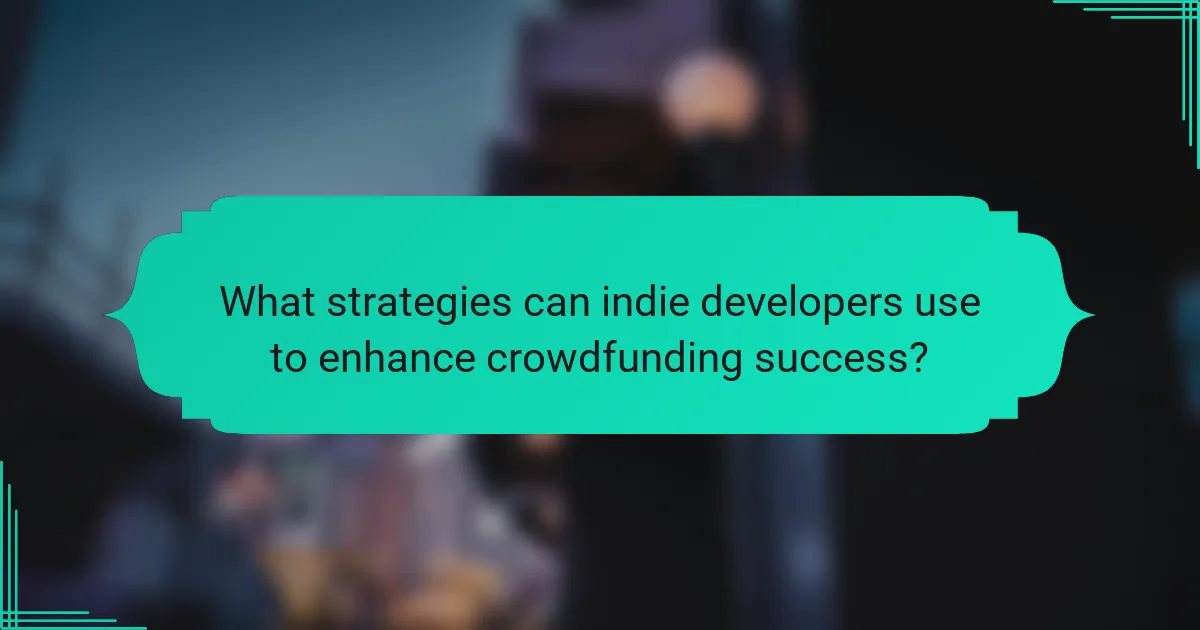
What strategies can indie developers use to enhance crowdfunding success?
Indie developers can enhance crowdfunding success by leveraging effective marketing strategies, engaging storytelling, and community involvement. Building a strong social media presence can attract backers. Creating a compelling video pitch enhances emotional connection. Setting clear funding goals and offering unique rewards can motivate contributions. Regular updates keep backers informed and engaged throughout the campaign.
How can storytelling impact the effectiveness of a campaign?
Storytelling significantly enhances campaign effectiveness by creating emotional connections. Engaging narratives capture attention, foster trust, and encourage support. For indie games, storytelling can showcase unique game elements, appealing to potential backers. A compelling story can increase funding success rates, as it resonates with the audience’s interests and values.
What role do visuals and prototypes play in attracting backers?
Visuals and prototypes are crucial in attracting backers for crowdfunding campaigns. They create an engaging representation of the game, showcasing its unique attributes and gameplay mechanics. High-quality visuals can evoke emotional responses, fostering a connection between the project and potential supporters. Prototypes allow backers to experience the game concept firsthand, increasing trust and credibility. Effective use of visuals and prototypes can significantly enhance a campaign’s success by clearly communicating the project’s vision and potential.
Which marketing channels are most effective for promoting campaigns?
Social media, email marketing, and influencer partnerships are the most effective channels for promoting crowdfunding campaigns for indie games. These platforms enable direct engagement with target audiences and foster community support.
Social media platforms like Twitter and Facebook allow for real-time updates and interaction, enhancing visibility. Email marketing provides a personalized approach, reaching dedicated supporters directly. Influencer partnerships leverage established audiences, increasing credibility and reach.
Combining these channels can maximize campaign success, as they complement each other in building awareness and driving contributions.
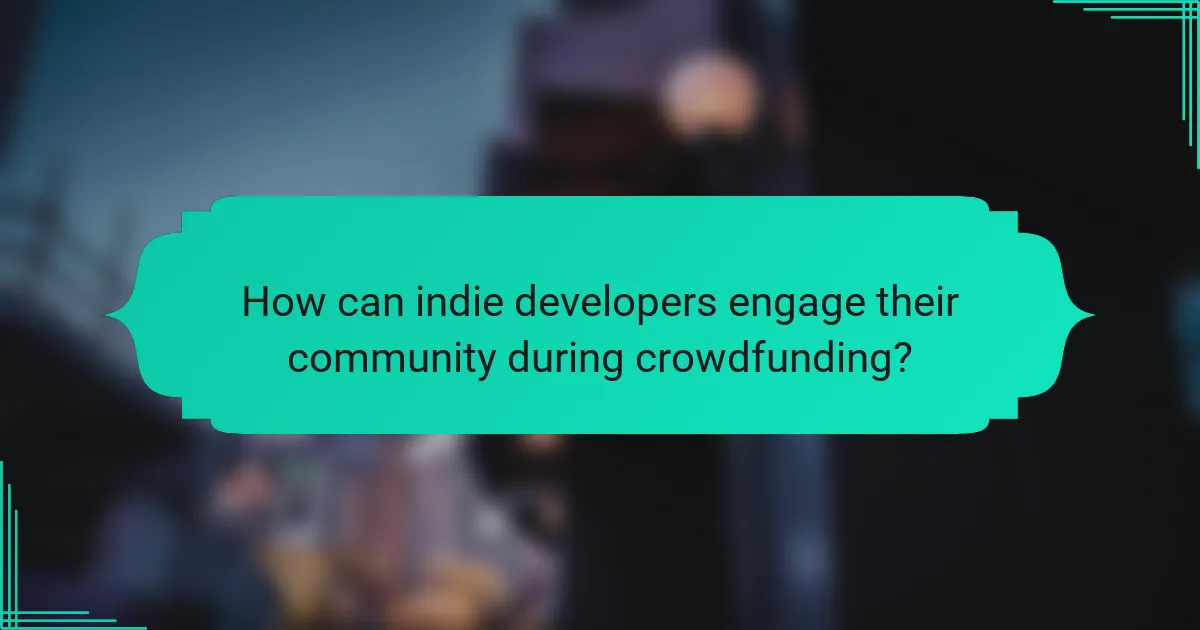
How can indie developers engage their community during crowdfunding?
Indie developers can engage their community during crowdfunding by fostering interaction and transparency. Effective strategies include regular updates, hosting Q&A sessions, and creating exclusive content for backers. Utilizing social media platforms enhances visibility and encourages discussions. Building a sense of community through feedback loops strengthens relationships and increases trust. Offering tiered rewards tailored to community interests can further boost engagement and support.
What are effective ways to build a loyal fanbase before launching a campaign?
Building a loyal fanbase before launching a crowdfunding campaign for indie games involves strategic engagement and community building. Start by creating a strong online presence through social media platforms and game development forums. Share regular updates about your game development process to foster excitement and transparency.
Engage with your audience by responding to comments, asking for feedback, and involving them in decision-making, such as character design or storyline choices. Host events, like live streams or Q&A sessions, to connect personally with potential backers.
Utilize email newsletters to keep your audience informed and engaged, offering exclusive content or sneak peeks. Collaborate with influencers in the gaming community to reach a broader audience and establish credibility.
Finally, consider offering early access or exclusive rewards for your supporters, creating a sense of value and belonging. This approach builds trust and loyalty, essential for a successful crowdfunding campaign.
How can developers maintain backer engagement throughout the campaign?
Developers can maintain backer engagement throughout the campaign by providing regular updates, responding to comments, and creating interactive content. Consistent communication fosters a sense of community and keeps backers informed about project progress. Gamifying the experience through stretch goals or rewards can also enhance engagement. Personalizing messages to backers can deepen their connection to the project, encouraging ongoing support.
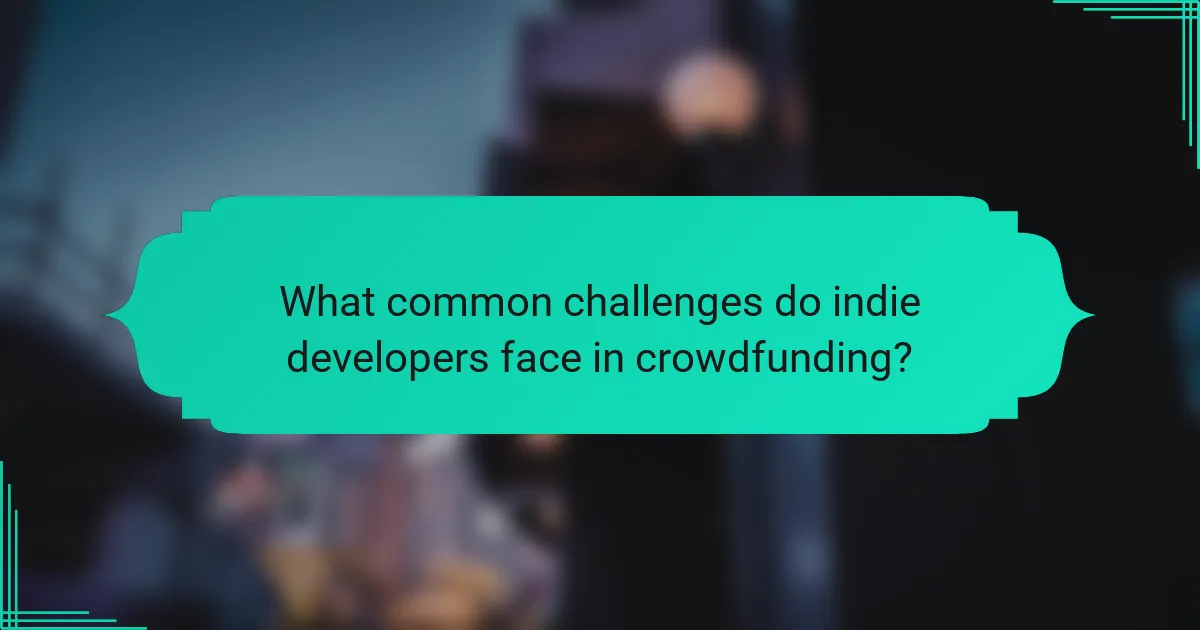
What common challenges do indie developers face in crowdfunding?
Indie developers face several common challenges in crowdfunding, including limited marketing budgets, lack of visibility, and building a community. These obstacles can hinder their ability to reach funding goals. Effective storytelling and engaging visuals can mitigate these issues, enhancing appeal to potential backers. Time management is also crucial, as developers must balance project development with campaign promotion.
How can budget constraints affect campaign planning and execution?
Budget constraints significantly limit the resources available for campaign planning and execution. They affect the quality and reach of marketing efforts, reducing the ability to engage potential backers effectively. Limited funds may necessitate prioritizing essential elements such as video production, promotional materials, and platform fees. Additionally, budget restrictions can hinder outreach strategies, leading to a reliance on organic growth rather than paid advertising. This can impact overall campaign visibility and success rates in the competitive indie game market.
What are the most frequent pitfalls to avoid during a campaign?
Common pitfalls to avoid during a crowdfunding campaign for indie games include inadequate market research, unrealistic funding goals, poor marketing strategies, and lack of community engagement.
1. Inadequate market research leads to misaligned expectations and target audiences.
2. Unrealistic funding goals can deter potential backers.
3. Poor marketing strategies fail to generate interest and visibility.
4. Lack of community engagement results in diminished support and feedback.
5. Ignoring updates and communication can alienate backers.
6. Underestimating production costs may lead to project shortfalls.
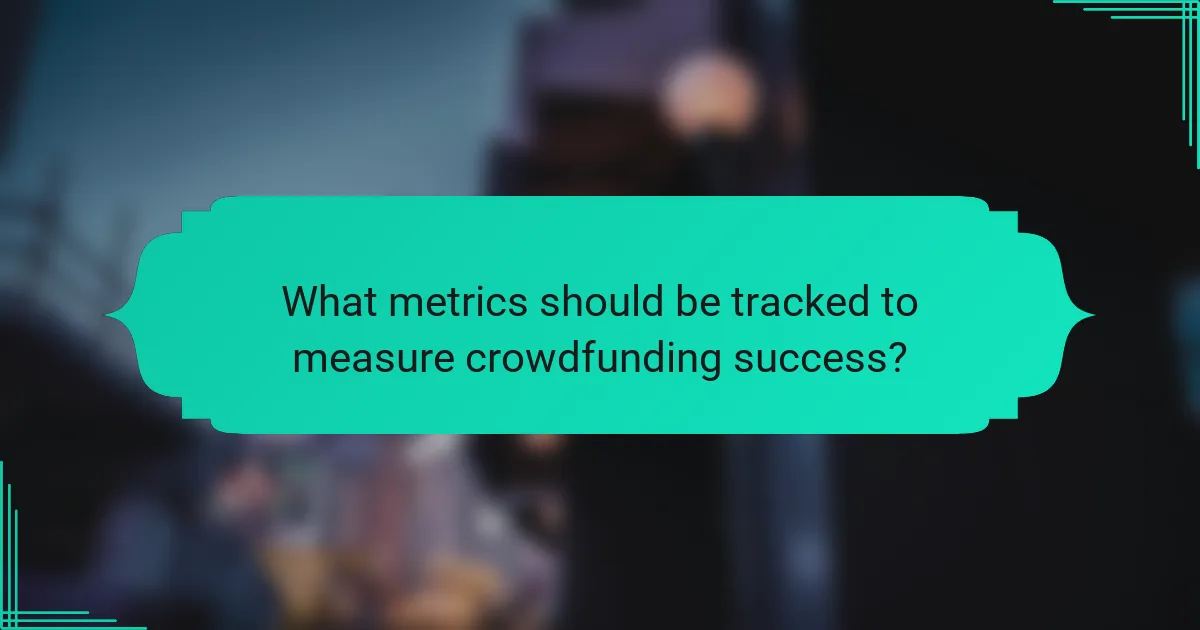
What metrics should be tracked to measure crowdfunding success?
To measure crowdfunding success for indie games, track metrics like total funds raised, backer count, funding goal percentage, average pledge amount, and campaign engagement. These metrics provide insights into financial performance and community interest.
| Metric | Description |
|——————————|————————————————|
| Total Funds Raised | Overall amount collected during the campaign |
| Backer Count | Total number of individuals who pledged |
| Funding Goal Percentage | Ratio of funds raised to the initial goal |
| Average Pledge Amount | Mean contribution per backer |
| Campaign Engagement | Interaction levels through comments and shares |
How do backer demographics influence funding outcomes?
Backer demographics significantly influence funding outcomes in crowdfunding for indie games. Understanding the age, gender, interests, and location of potential backers helps tailor campaigns effectively. For example, younger backers may prefer innovative gameplay, while older backers might focus on nostalgia. This demographic insight allows creators to craft targeted messaging and rewards, enhancing engagement and funding success.
What are the indicators of a successful crowdfunding campaign?
Successful crowdfunding campaigns for indie games exhibit clear indicators such as strong community engagement, effective marketing strategies, and achievable funding goals. These elements drive visibility and support.
Key indicators include:
1. **Pre-launch buzz**: Building anticipation through social media and newsletters.
2. **Clear project goals**: Setting realistic funding targets and timelines.
3. **Compelling rewards**: Offering attractive incentives for backers.
4. **Engagement metrics**: Monitoring comments, shares, and backer interactions.
5. **Regular updates**: Keeping backers informed fosters trust and loyalty.
6. **Strong visuals**: High-quality images and videos enhance appeal and clarity.
These factors collectively contribute to a campaign’s success, ensuring it resonates with potential backers.
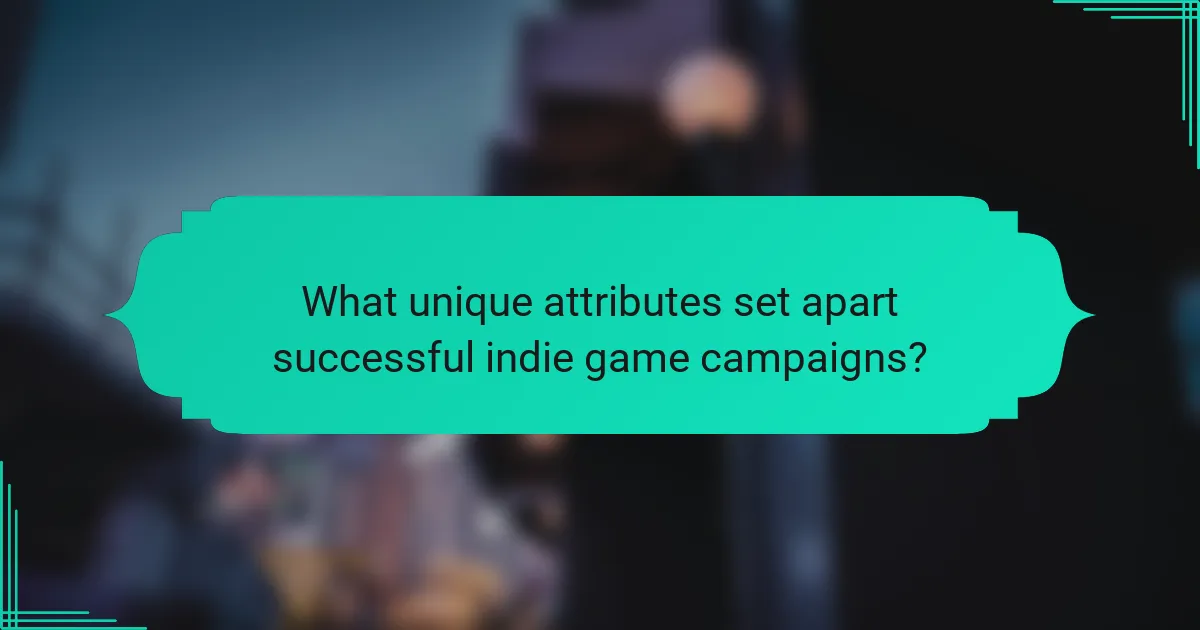
What unique attributes set apart successful indie game campaigns?
Successful indie game campaigns often stand out due to their unique storytelling, community engagement, and innovative rewards. These elements create a strong emotional connection with backers, enhancing their investment in the project.
Unique storytelling captures the essence of the game, showcasing its narrative and artistic vision. Community engagement fosters a loyal following, encouraging backers to share the campaign within their networks. Innovative rewards, such as exclusive in-game content or personalized experiences, appeal to backers’ desires for unique value.
Additionally, transparency about funding goals and project timelines builds trust, further distinguishing successful campaigns. This combination of attributes creates a compelling case for support, setting successful indie game campaigns apart from the rest.
How does the choice of rewards impact backer motivation?
The choice of rewards significantly influences backer motivation in crowdfunding for indie games. Attractive and unique rewards can enhance engagement and drive funding success.
Backers are motivated by perceived value, including exclusive content, early access, or personalized experiences. For example, offering limited edition merchandise can create a sense of urgency and exclusivity.
Moreover, aligning rewards with the interests of the target audience increases their appeal. Engaging backers through tiered reward systems can encourage higher contributions, as they feel a stronger connection to the project.
Ultimately, the right rewards can differentiate a campaign, fostering community and loyalty among supporters, which is critical for long-term success in the indie game market.
What innovative campaign formats have emerged in recent years?
Crowdfunding for indie games has seen innovative campaign formats like tiered rewards, livestream funding events, and social media challenges. These formats engage backers more interactively and create a sense of community. For instance, tiered rewards allow backers to choose different levels of support, receiving unique benefits like exclusive content. Livestream funding events enable real-time interaction, fostering a stronger connection between developers and supporters. Social media challenges can amplify visibility, encouraging fans to share campaigns widely. These strategies enhance funding potential and build a loyal fanbase.
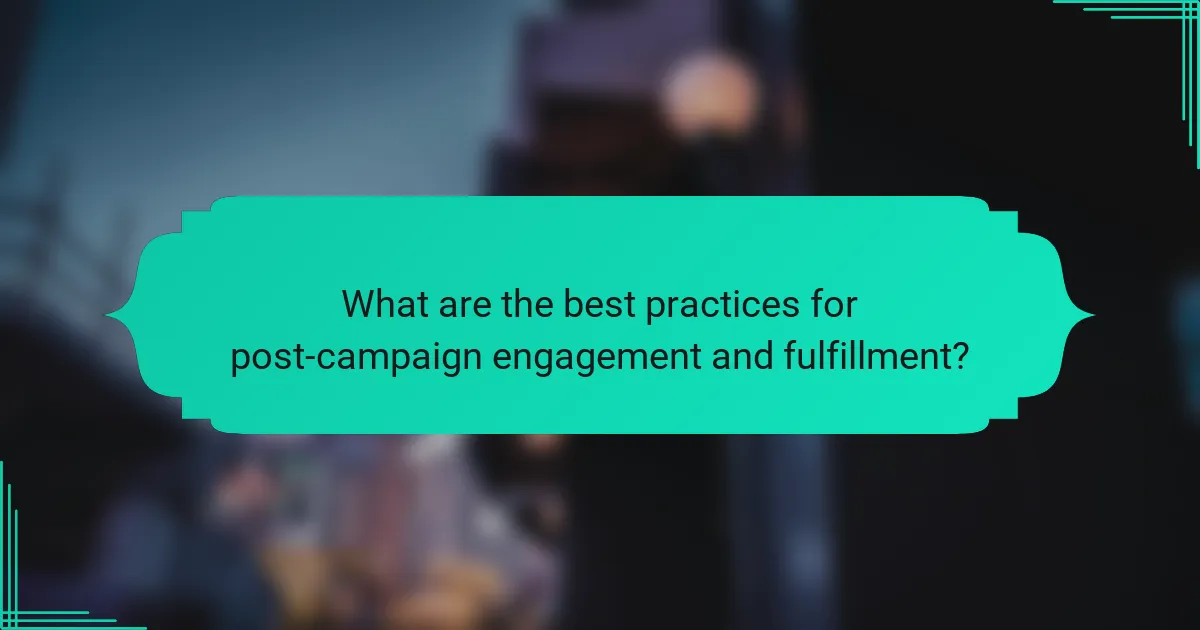
What are the best practices for post-campaign engagement and fulfillment?
Effective post-campaign engagement and fulfillment for crowdfunding indie games involves maintaining communication, delivering rewards timely, and fostering community. Engaging backers through updates enhances loyalty and encourages future support. Timely fulfillment of rewards, such as game copies or exclusive content, builds trust and satisfaction. Community building through forums or social media helps maintain interest and creates a dedicated fanbase.
How can developers effectively communicate with backers post-funding?
Developers can effectively communicate with backers post-funding by providing regular updates, engaging through social media, and responding promptly to inquiries. Consistent communication fosters trust and keeps backers informed about project progress. Transparency about challenges and milestones enhances backer relationships. Utilizing platforms like newsletters or dedicated forums can further strengthen community engagement.
What strategies ensure timely delivery of rewards to backers?
Timely delivery of rewards to backers in crowdfunding requires clear communication, realistic timelines, and efficient logistics. Establish a detailed schedule for reward fulfillment, ensuring backers are informed of progress. Use reliable shipping partners to minimize delays. Regular updates build trust and keep backers engaged.
What expert tips can help maximize the impact of a crowdfunding campaign?
To maximize the impact of a crowdfunding campaign for indie games, focus on clear communication, engaging visuals, and strategic marketing. Build a compelling narrative that highlights the game’s unique attributes and value. Utilize social media to create buzz and connect with potential backers. Offer attractive rewards to incentivize contributions and maintain regular updates to keep supporters engaged.
